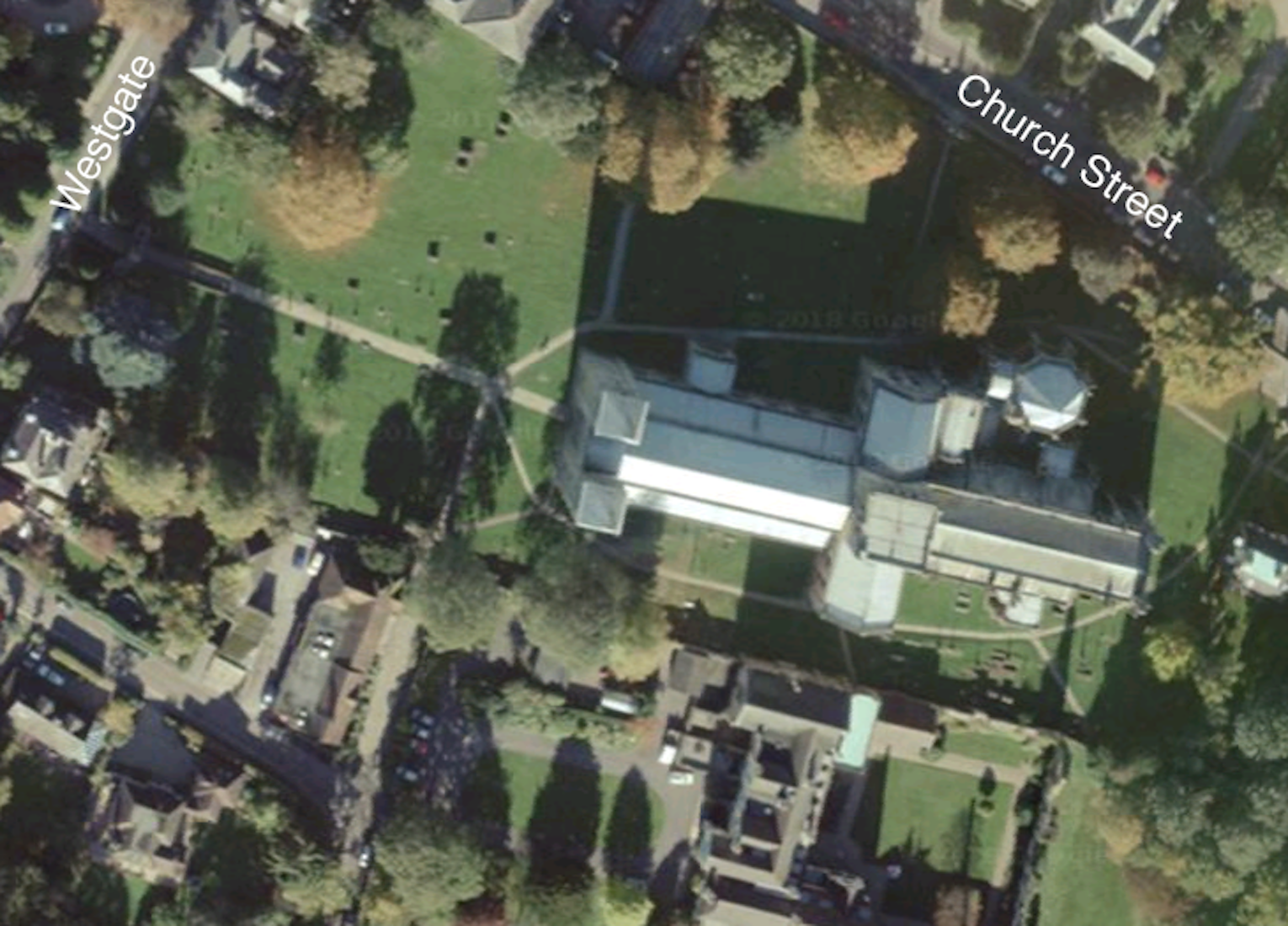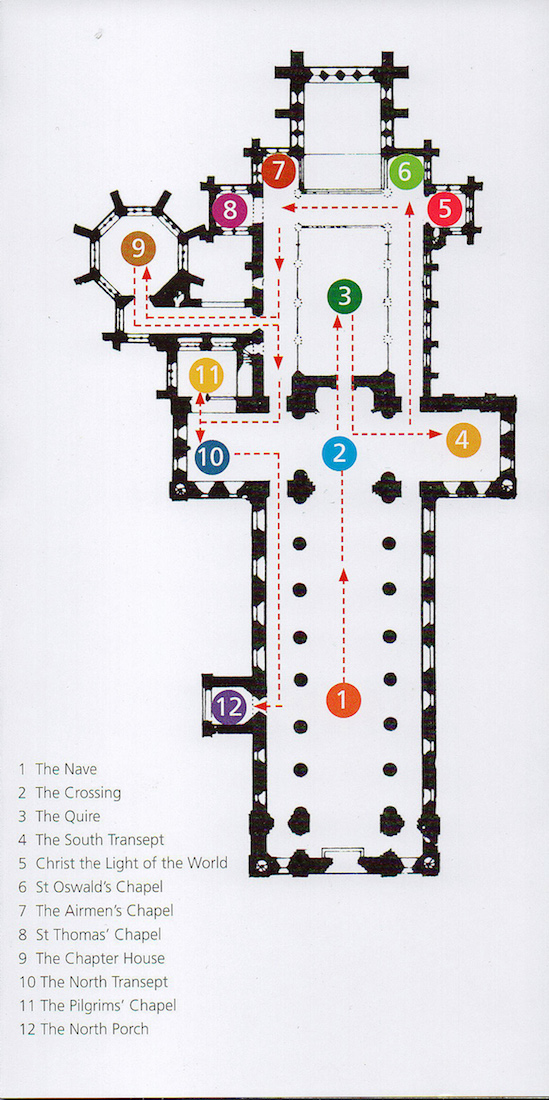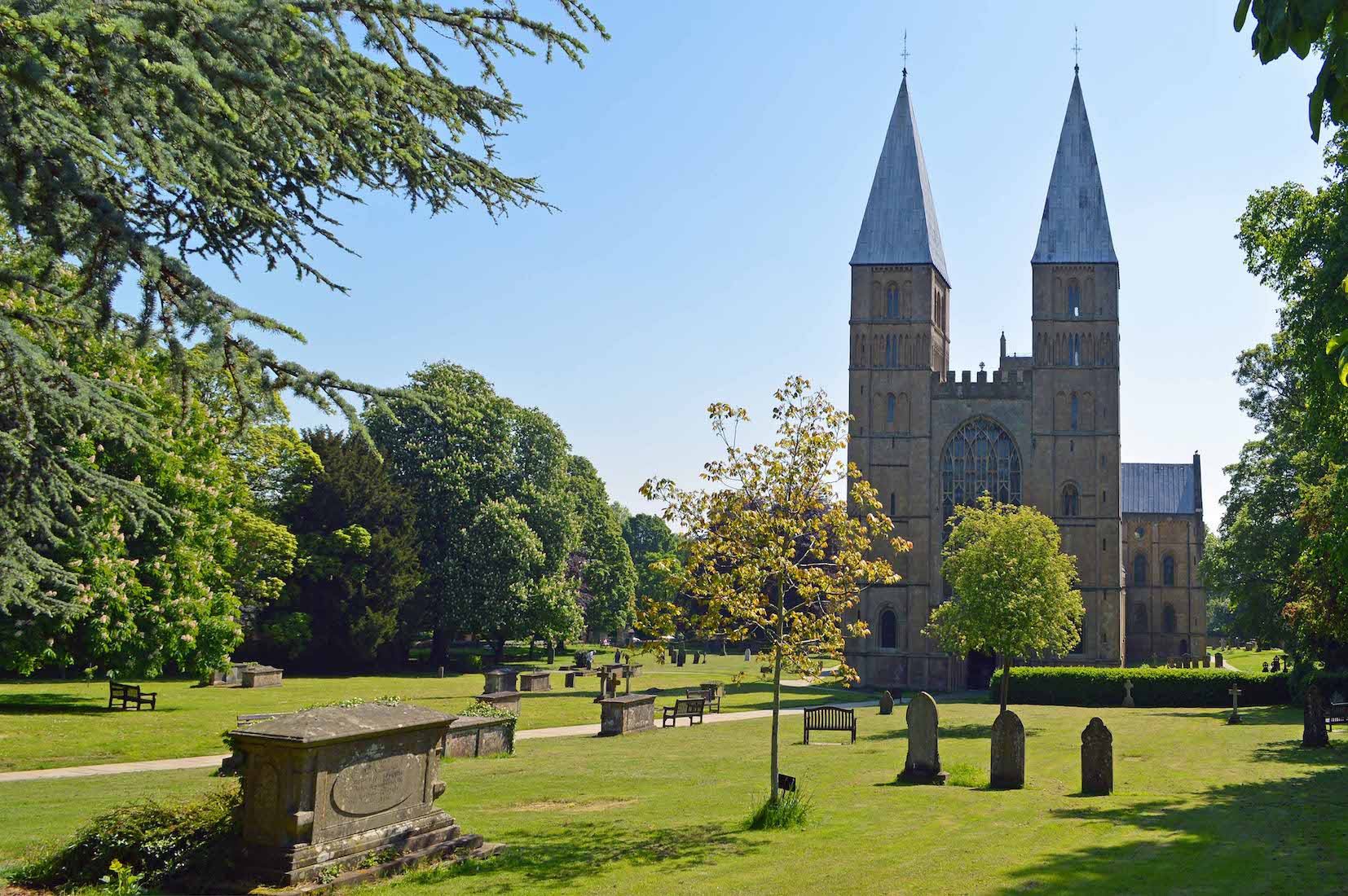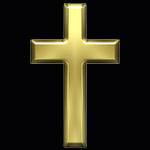SOUTHWELL MINSTER (CATHEDRAL)
SOUTHWELL ENGLAND
PAUL SCOTT

SATELLITE VIEW
The Cathedral has an almost east-west axis geographically, so we can assume our liturgical and geographical directions coincide.
The Cathedral is essentially cruciform in shape with two square towers at the Western end, a central square tower, chapels adjoining the sanctuary, and a chapter house to the Northeast. The Bishops’ Garden and the ruins of the Bishops’ Palace can be seen to the South.
We begin our exploration at Westgate (to the left), and follow around the cathedral in an anticlockwwise direction, before entering by the North nave porch.

This is the plan given in the excellent Cathedral publication ‘Southwell Minster – A Visitor’s Companion’. The numbers refer to the commentary in the booklet.
On this site we follow our own course (of course!), but coincidentally following fairly closely the indicated path. We enter by the North Porch [12], explore the nave [1], North transept [10] and Pilgrims’ Chapel [11], before returning to the crossing [2]. From here we follow the numbers: quire [3], South transept [4], chapels [5] – [8] including the unmarked sanctuary, and finally the chapter house [9].
The Minster appears to regard the sanctuary as part of the quire. Enjoy this fine Cathedral with me!
A brief history of the Cathedral is given below. However, if you want to begin your tour of the Cathedral immediately, tap / click on START . You can also access intermediate points in the tour by a tap / click on the following links:
NOTE ON MAGNIFYING IMAGES
With this website format the images are large enough for most purposes. If there is a need for greater magnification of an image, go to the identical photo on
https://www.flickr.com/photos/paulscottinfo/albums
and use Command - + (Mac) or Windows - + (Windows).
HISTORY
[Wikipedia]
Middle Ages
The earliest church on the site is believed to have been founded in 627 by Paulinus, the first Archbishop of York, when he visited the area while baptising believers in the River Trent. The legend is commemorated in the Minster’s baptistry window.
In 956 King Eadwig gave land in Southwell to Oskytel, Archbishop of York, on which a minster church was established. The Domesday Book of 1086 recorded the Southwell manor in great detail. The Norman reconstruction of the church began in 1108, probably as a rebuilding of the Anglo-Saxon church, starting at the East end so that the high altar could be used as soon as possible and the Saxon building was dismantled as work progressed. Many stones from this earlier Anglo-Saxon church were reused in the construction. The tessellated floor and late 11th century tympanum in the North transept are the only parts of the Anglo-Saxon building remaining intact. Work on the nave began after 1120 and the church was completed by c.1150.
The church was originally attached to the Archbishop of York’s Palace which stood next door and is now ruined. It served the archbishop as a place of worship and was a collegiate body of theological learning, hence its designation as a minster. The minster draws its choir from the nearby school with which it is associated.
The Norman chancel was square-ended. The chancel was replaced with another in the Early English style in 1234–51 because it was too small. The octagonal chapter house, was built starting in 1288 with a vault in the Decorated Gothic style, and has naturalistic carvings of foliage (the 13th-century stone carving includes several Green Men). The elaborately carved ‘pulpitum’ or choir screen was built in 1320–40.
Reformation and civil war
The church suffered less than many others in the English Reformation as it was refounded in 1543 by Act of Parliament.
Southwell is where Charles I was captured during the English Civil War, in 1646. The fighting saw the church seriously damaged and the nave is said to have been used as stabling. The adjoining palace was almost completely destroyed, first by Scottish troops and then by the local people, with only the Hall of the Archbishop remaining as a ruined shell. The Minster’s financial accounts show that extensive repairs were necessary after this period.
18th century
On 5 November 1711 the Southwest spire was struck by lightning, and the resulting fire spread to the nave, crossing and tower destroying roofs, bells, clock and organ. By 1720 repairs had been completed, now giving a flat panelled ceiling to the nave and transepts.
Victorian
In 1805 Archdeacon Kaye gave the Minster the Newstead lectern; once owned by Newstead Abbey, it had been thrown into the Abbey fishpond by the monks to save it during the Dissolution of the Monasteries, then later discovered when the lake was dredged. Henry Gally Knight in 1818 gave the Minster four panels of 16th century Flemish glass (which now fill the bottom part of the East window) which he had acquired from a Parisian pawnshop.
In danger of collapse, the spires were removed in 1805 and re-erected in 1879–81 when the minster was extensively restored by Ewan Christian, an architect specialising in churches. The nave roof was replaced with a pitched roof and the choir was redesigned and refitted.
Ecclesiastical history
Collegiate church
Southwell Minster was served by prebendaries from the early days of its foundation. By 1291 there were 16 Prebends of Southwell mentioned in the Taxation Roll.
In August 1540, as the dissolution of the monasteries was coming to an end, and despite its collegiate rather than monastic status, Southwell Minster was suppressed specifically in order that it could be included in the plans initiated by King Henry VIII to create several new cathedrals. It appears to have been proposed as the see for a new diocese comprising Nottinghamshire and Derbyshire, as a replacement for Welbeck Abbey which had been dissolved in 1538 and which by 1540 was no longer owned by the Crown.
The plan for the minster’s elevation did not proceed, so in 1543 Parliament reconstituted its collegiate status as before. In 1548 it again lost its collegiate status under the 1547 Act of King Edward VI which suppressed (among others) almost all collegiate churches: at Southwell the prebendaries were given pensions and the estates sold, while the church continued as the parish church on the petitions of the parishioners.
By an Act of Philip and Mary in 1557, the minster and its prebends were restored. In 1579 a set of statutes was promulgated by Queen Elizabeth I and the chapter operated under this constitution until it was dissolved in 1841. The Ecclesiastical Commissioners made provision for the abolition of the chapter as a whole; the death of each canon after this time resulted in the extinction of his prebend. The chapter came to its appointed end on 12 February 1873 with the death of Thomas Henry Shepherd, rector of Clayworth and prebendary of Beckingham.
Cathedral
In 1884 Southwell Minster became a cathedral proper for Nottinghamshire and a part of Derbyshire including the city of Derby. The diocese was divided in 1927 and the Diocese of Derby was formed. The diocese’s centenary was commemorated by a royal visit to distribute Maundy money. George Ridding, the first Bishop of Southwell, designed and paid for the grant of Arms now used as the diocesan coat of arms.



